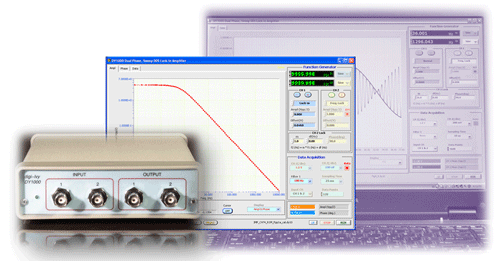
A unique instrument for the detection of weak voltage signals (down to µV) in a noisy background.
Overview
Lock-in amplifiers are widely used in physics, chemistry, biology, and many other fields to detect very weak signals in the presence of a noisy background. However, in many cases, such usefulness could be limited by the complicated operation of conventional lock-in amplifiers. The DY1000 Sweep DDS Lock-In Amplifier by Digi-Ivy introduces a new and convenient way to operate lock-in amplifiers. Based on modern semiconductor circuitry and advanced software programming, a harmonious combination of universality in application and simplicity in operation has been achieved:
- Fully automatic operation
The user inputs control parameters from an easy to use PC interface, then the instrument conducts all of the measurement procedures, taking care of auto frequency sweep, auto gain control, synchronized data acquisition, data analysis and data display. The user will not only enjoy the unique simplified operation of the DY1000, but also, most importantly, acquire experimental data both accurately and quickly.
- High accuracy
A dual-channel DDS (Direct Digital Synthesis) function generator which provides sine or triangle waves with 0.008Hz resolution and 50ppm drift has been used as a signal source. The analog input section contains DC-coupled low noise instrument amplifiers, variable gain stages and corresponding filters which provide precision signal pass for the measurement.
- Low frequency (fmin = 0.008Hz) and Harmonic (1.0f, 2.0f, 3.0f…100.0f) detection
- Non integral harmonics
In addition to locking at the integral multiple frequencies of the reference signal, the DY1000 can also be used to lock at non-integral multiple frequencies (such as 1.5f, 3.6f …). As the only lock-in amplifier available with this capability, the DY1000 provides the ability to study new phenomena, for example, in the dynamic response of nonlinear systems.
- Multiple applications
In addition to its use as a lock-in amplifier, the DY1000 can also be used as:
- Dual-channel synchronized function generator
- Variable-gain low-noise amplifier
- Variable-gain data acquisition system
- FFT analyzer, and many other user-defined applications
- Lightweight and compact design. USB connection
Applications
- Auto Sweep Lock-in Amplifier
- Dual-CH Precision Sine/Triangle Waveform Generation
- Dual-CH digital data acquisition
- FFT Spectrum Analyzer
- Synchronized precision Lissajous figures
- Signal conditioning for sensor applications
- Impedance Analyzer
- Many other user-configurable applications
Downloads
Specifications
Lock-In Amplifier
| Frequency Range | 0.008Hz to 10 kHz Full-scale |
| Input Range | ±500µV to ±10 V in 14 steps |
| Harmonic detection | 1.0f, 2.0f, …, 100.0f to 10 kHz (include non-integral numbers) |
| Low Pass Filter | 270 kHz, 2.7 kHz, 27 Hz, 0.27 Hz |
| Input Impedance | 1 MOhm || 20 pF (DC Coupling) |
Function Generators
| Number of Outputs | 2 |
| Max output current | ±50 mA |
| Waveforms | Sine, Triangle and DC (50 Ohms output impedance) |
| Frequency Range | 0.008Hz to 100 kHz* (DDS clock at 2.00 MHz) |
| Resolution | 0.008Hz |
| Stability | 50 ppm |
| Phase offset | 0 to 360 deg. |
| Resolution | 0.1 deg. |
| Amplitude | 0.02Vpp to 20 Vpp into Hi-Z |
| Resolution | 10 mV (Hi-Z) |
| Accuracy | < 1% of full scale |
| Offset | ±8 V (Hi-Z) |
| Resolution | 10 mV |
| Accuracy | < 1% of full scale |
| Modulation | AM (CH2 only) |
| Source | CH1 output or External input |
| Frequency Sweep | Linear or logarithmic* |
| Direction | Up or down |
| Harmonic Distortion | < -50 dB (at 10 kHz) |
*: CH2 frequency can be locked to CH1 during normal/sweep operation. See user manual for more information.
Data Acquisition
| Number of Inputs | 2 (differential inputs) |
| Full-scale Input Range (CH1) | ±10 V |
| Full-scale Input Range (CH2) | ±500µV to ±10 V in 14 steps |
| Sampling Rate | 1 Hz to 100 kHz in 16 steps |
| Maximum Data Points | 5000 / CH (12-bit) |
General
| Dimensions (W x D x H) & Weight | 15 x 26 x 5 cm, 1kg |
| Power Requirements | 100-240 VAC, 0.5A, 47-63 Hz |
| Computer Interface | USB with PCs running Windows |